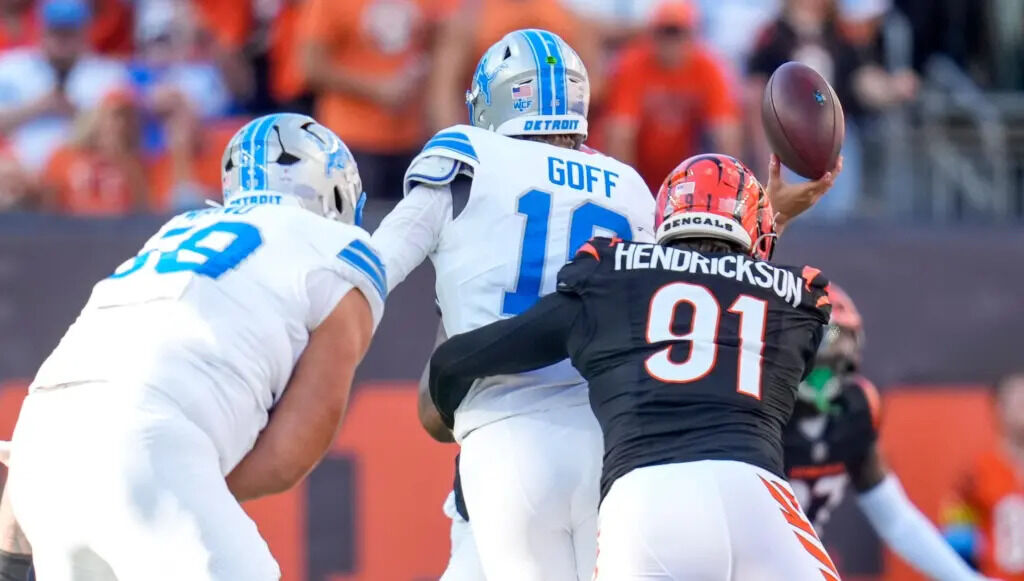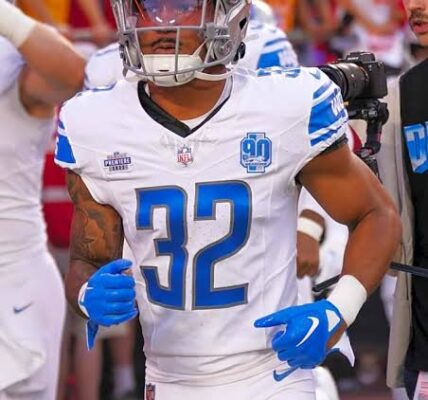The Detroit Lions faced a major test in their latest matchup against the Kansas City Chiefs at Arrowhead Stadium. Despite a competitive effort, Detroit ultimately fell short, losing 30–17. The defeat dropped their record to 4–2 but also offered fascinating revelations about the team’s snap distribution and evolving game plan.
Quarterback Breakdown
J ared Goff commanded the offense, taking all 54 snaps under center. He turned in a steady performance, completing 23 of 29 passes for 203 yards and two touchdowns. However, the Lions’ offense lacked its usual explosiveness. Though Goff remained accurate, the absence of deep passing opportunities limited Detroit’s scoring potential, particularly during key moments.
Running Back Rotation
The running back snap counts revealed a distinct shift in approach. Jahmyr Gibbs dominated the workload, logging 37 snaps—69% of the total—while David Montgomery played 17, or 31%. Gibbs handled 27 carries compared to Montgomery’s four, signaling a clear change in offensive emphasis. Facing a stout Kansas City front, Detroit leaned heavily on screen passes instead of their traditional power run scheme.
Wide Receiver Usage
Amon-Ra St. Brown and Jameson Williams led the receiving unit, with snap totals of 48 and 46, respectively. St. Brown had an uncharacteristic drop that stalled a key drive before halftime, while Williams delivered his strongest game of the year, catching six passes and a touchdown. With Kalif Raymond sidelined by a neck injury, Isaac TeSlaa stepped into the WR3 role, logging 25 snaps and showing promise in extended action.
Tight End Production
At tight end, Sam LaPorta continued to play a starring role, appearing in 52 snaps—96% of Detroit’s offensive plays. He hauled in five receptions, maintaining his consistency as a dependable target. Brock Wright contributed on 57% of plays, while Ross Dwelly was used sparingly in jumbo formations, reflecting Detroit’s preference for flexibility and varied personnel packages.
Offensive Line Configuration
Injuries to Taylor Decker and Giovanni Manu forced the Lions to adjust, inserting Dan Skipper at left tackle. The offensive line—Christian Mahogany, Tate Ratledge, Penei Sewell, Dan Skipper, and Graham Glasgow—played every snap together. Trystan Colon saw limited usage in heavy sets. The consistent alignment reflected Detroit’s focus on cohesion and resilience despite personnel losses.
Defensive Snap Insights
Defensively, Aidan Hutchinson and DJ Reader led the charge, playing 61 and 43 snaps, respectively. Tyler Lacy’s increased workload over Mekhi Wingo suggested subtle adjustments to the defensive rotation. Newly promoted Quinton Jefferson also made an impact in his first game with the team, adding depth and experience to the front line.
Linebacker Consistency
At linebacker, the Lions showed remarkable stability. Jack Campbell, Alex Anzalone, and Derrick Barnes each played all 64 defensive snaps. Barnes continued to split time between defense and special teams, emphasizing Detroit’s reliance on its most versatile players to maintain tempo and balance throughout the game.
Cornerback Performance
Detroit’s secondary faced a daunting challenge against Kansas City’s high-powered passing attack. Rock Ya-Sin and Amik Robertson saw the bulk of the action, while Arthur Maulet appeared sparingly in his Lions debut. Though the unit endured some tough stretches, improved chemistry and communication are expected as the group gains experience together.
Safety Play and Special Teams
Brian Branch remained a constant presence, logging every defensive snap, though he will serve a one-game suspension following a postgame incident. Kerby Joseph battled through injury to record 53 snaps. On special teams, Jake Bates, Jack Fox, and Hogan Hatten all contributed in crucial moments, helping sustain field position and momentum.
This breakdown of snap counts sheds light on both individual contributions and broader tactical adjustments. The Lions’ staff clearly tailored their plan to the Chiefs’ strengths, emphasizing adaptability and player versatility. As the season progresses, these patterns could significantly influence Detroit’s future lineups and in-game decisions.




